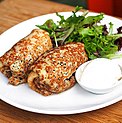List of Russian dishes
From Wikipedia, the free encyclopedia
This is a list of notable dishes found in Russian cuisine.[1] Russian cuisine is a collection of the different cooking traditions of the Russian Empire. The cuisine is diverse, with Northeast European/Baltic, Caucasian, Central Asian, Siberian, East Asian and Middle Eastern influences.[2] Russian cuisine derives its varied character from the vast and multi-ethnic expanse of Russia.
Russian dishes
Zakuski (hors d'oeuvre)
| Name | Image | Description |
|---|---|---|
| Caviar |  |
Known as ikra. Processed, salted roe, often of sturgeon[3] |
| Courgette caviar |  |
Cold entrée made of stewed vegetables (predominantly courgettes). Usually it is eaten with bread[4] |
| Julienne |  |
Мushrooms in cream or béchamel sauce topped with grated cheese and baked in a cocotte. Chicken, fish or seafood can also be used with or instead of mushrooms. |
| Kholodets |  |
An aspic that is also known as studen[5][6] |
| Salo |  |
A dish consisting of cured slabs of fatback with or without skin |
| Stroganina |  |
A dish of the indigenous people of northern Arctic Siberia consisting of raw, thin, long-sliced frozen fish. |
| Zakuski |  |
Refers to a variety of hors d'oeuvres, snacks, appetizers, usually served buffet style.[7] It often includes cold cuts, cured fishes, mixed salads, kholodets, various pickled vegetables and mushrooms, pirozhki, caviar, deviled eggs, open sandwiches, canapés and breads.[7] |
Soups
| Name | Image | Description |
|---|---|---|
| Okroshka |  |
Cold soup of mostly raw vegetables like cucumbers, spring onions, boiled potatoes, with eggs, and a cooked meat such as beef, veal, sausages, or ham with kvass, topped with sour cream[8] |
| Rassolnik | 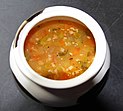 |
A soup made from pickled cucumbers, pearl barley, and pork or beef kidneys[9] |
| Shchi |  |
A cabbage soup.[10] Also can be based on sauerkraut.[10] Kislye Shchi (sour shchi) despite its name is a fizzy beverage similar to kvass, usually with honey.[citation needed] |
| Borscht |  |
It is traditionally made from meat or bone stock, sautéed vegetables, and beet sour (i.e., fermented beetroot juice). Depending on the recipe, some of these components may be omitted or substituted. |
| Svekolnik |  |
Cold borscht involves use of dairy products and halves of boiled eggs. |
| Solyanka | 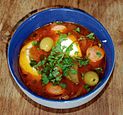 |
A thick, spicy and sour soup that contains meat and pickled cucumbers[11] |
| Fish Solyanka |  |
Variation of solyanka replacing meat with fish. |
| Shchavel soup (green shchi) |
 |
Water or broth, sorrel leaves, salt, sometimes with whole eggs or egg yolks, potatoes, carrots, parsley root, and rice[12][13] |
| Ukha |  |
A clear soup, made from various types of fish[14] |
Salads
| Name | Image | Description |
|---|---|---|
| Dressed herring (Seld pod shuboi) |  |
Diced, salted herring covered with layers of grated, boiled vegetables (potatoes, carrots, beet roots), chopped onions, and mayonnaise[15][5] |
| Mimosa salad |  |
A festive salad, whose main ingredients are cheese, eggs, canned fish, onion, and mayonnaise[citation needed] |
| Olivier salad (Stolichniy salad) |  |
Diced potatoes, eggs, chicken or bologna, sweet peas, and pickles with a mayonnaise dressing. Other vegetables, such as carrot or fresh cucumbers, can be added.[16][5] |
| Vinegret |  |
Diced boiled vegetables (beet roots, potatoes, carrots), chopped onions, and sauerkraut and/or pickled cucumbers.[17][18][19] Other ingredients, such as green peas or beans, are sometimes also added.[18][19] Dressed with vinaigrette, mayonnaise or simply with sunflower or other vegetable oil. |
Meat dishes
| Name | Image | Description |
|---|---|---|
| Beef Stroganov |  |
Pieces of sautéed beef in sauce, with smetana (sour cream)[20] |
| Chicken Kiev |  |
A dish made of chicken fillet pounded and rolled around cold butter, then coated with eggs and bread crumbs, and either fried or baked. |
| Golubtsy |  |
Cooked cabbage leaves wrapped around a variety of fillings[21][5] |
| Makarony po-flotski |  |
Literally navy-style pasta, a dish made of cooked pasta (typically macaroni, penne or fusilli) mixed with stewed ground meat, fried onions and seasoned with salt and black pepper. |
| Pelmeni |  |
Dumplings consisting of a meat filling wrapped in thin, pasta dough[22][23][5] |
| Pozharsky cutlet |  |
A breaded ground chicken patty[24] |
| Shashlyk |  |
A dish of skewered and grilled cubes of meat. |
| Veal Orlov |  |
A dish invented by the French[25] consisting of braised loin of veal, thinly sliced, filled with a thin layer of pureed mushrooms and onions between each slice, topped with bechamel sauce and cheese. Various versions of this dish usually go by the name French-style meat in Russia today. |
Pancakes
Bread
| Name | Image | Description |
|---|---|---|
| Baranka |  |
A dough ring somewhat smaller than a bublik, but also thinner and drier |
| Borodinsky bread | 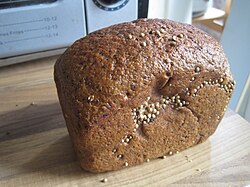 |
Dark brown sourdough rye bread |
| Bublik |  |
A ring of yeast-leavened wheat dough, that has been boiled in water for a short time before baking |
| Karavai |  |
A large round braided bread, traditionally baked from wheat flour and decorated with symbolic flags and figurines, such as suns, moons, birds, animals, and pine cones. |
| Kalach |  |
Historically, kalach meant any kind of white bread, and before modern methods of grinding wheat came into use, white bread was classed as a type of fancy bread. |
| Kulich |  |
One of the two sine qua non attributes of the Russian Easter (the other is Paskha).[30] A type of Easter bread.[30] |
| Sushki |  |
Traditional small, crunchy, mildly sweet bread rings eaten for dessert, usually with tea or coffee |
Pirogi (pies)
| Name | Image | Description |
|---|---|---|
| Kulyebyaka |  |
A fish (usually salmon or sturgeon) loaf, with rice, hard-boiled eggs, mushrooms, and dill[31] |
| Karelsky pirog |  |
A traditional pirog from the region of Karelia. |
| Kurnik | 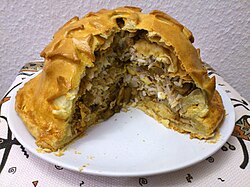 |
A dome-shaped savoury type of Russian pirog, usually filled with chicken or turkey, eggs, onions, kasha or rice, and other optional components.[32][33] |
| Rasstegai | 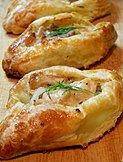 |
The filling usually contains fish, but may also contain meat, liver, rice or mushrooms. |
| Pirog |  |
A pie either with a sweet or savoury filling[34] |
| Pirozhki |  |
Small pies[35][5] |
| Vatrushka |  |
A pastry with a ring of dough and sweet tvorog in the middle[36] |
Kasha (porridge)
| Name | Image | Description |
|---|---|---|
| Kasha |  |
Porridge. Buckwheat,[37] millet, oat and wheat kashas are widely popular in Russia.[38][5] |
| Gorokhovaya kasha |  |
Pease porridge, similar to British pease pudding. |
| Guriev porridge | 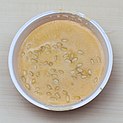 |
A Russian porridge dish prepared from semolina and milk with the addition of nuts (hazelnut, walnuts, almonds), kaimak (creamy foams) and dried fruits.[39] |
| Kutia |  |
A ceremonial grain dish with sweet gravy. |
| Mannaya kasha |  |
Semolina porridge, similar to the Guriev one. |
| Perlovka (Pearl barley kasha) |  |
Pearl barley porridge. |
Sauces
| Name | Image | Description |
|---|---|---|
| Khren |  |
A spicy paste made of grated horseradish. |
| Khrenovina |  |
A spicy horseradish sauce served with a main course, which is very popular in Siberia. |
| Smetana |  |
A dairy product produced by souring heavy cream. |
Desserts
| Name | Image | Description |
|---|---|---|
| Russian-style Charlotte |  |
A cold dessert of Bavarian cream set in a mold lined with ladyfingers.[40] |
| Medovik |  |
The identifying ingredients are honey and smetana (sour cream) or condensed milk. |
| Russian-style Napoleon cake |  |
A dessert made of puff pastry layered with pastry cream. |
| Paskha |  |
Tvorog (farmer's cheese) plus heavy cream, butter, sugar, vanilla, etc., usually molded in the form of a truncated pyramid. Traditional for Easter. |
| Pryanik |  |
A range of traditional sweet baked goods made from flour and honey. |
| Pastila |  |
It has been described as "small squares of pressed fruit paste" and "light, airy puffs with a delicate apple flavor". |
| Syrok |  |
A type of sweet dairy food made from glazed or unglazed curd cheese with or without filling. |
| Khvorost |  |
A traditional sweet crisp pastry made out of dough that has been shaped into thin twisted ribbons, deep-fried and sprinkled with powdered sugar |
| Pyshka (or Ponchik) |  |
A Russian variety of doughnut. |
| Varenye |  |
It is made by cooking berries, other fruits, or more rarely nuts, vegetables, or flowers, in sugar syrup. |
| Zefir |  |
A type of soft confectionery made by whipping fruit and berry purée (mostly apple puree) with sugar and egg whites with subsequent addition of a gelling agent like pectin, carrageenan, agar, or gelatine. |
Beverages
Non-alcoholic drinks
| Name | Image | Description |
|---|---|---|
| Kissel | 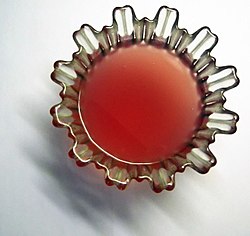 |
Fruit dessert of sweetened juice, thickened with arrowroot, cornstarch or potato starch[41] |
| Kompot |  |
Non-alcoholic sweet beverage, that may be served hot or cold, depending on tradition and season. It is obtained by cooking fruit such as strawberries, apricots, peaches, apples, rhubarb, gooseberries, or sour cherries in a large volume of water, often together with sugar or raisins as additional sweeteners. |
| Kvass |  |
A fermented non-alcoholic beverage made from black or regular rye bread or dough[42] |
| Mors | 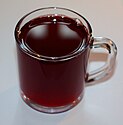 |
A non-carbonated Russian fruit drink[43][44][45] prepared from berries, mainly from lingonberry and cranberry (although sometimes blueberries, strawberries, sea buckthorns or raspberries). |
| Ryazhenka | 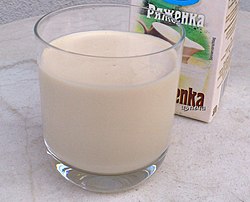 |
It is made from baked milk by lactic acid fermentation.[46] |
| Sbiten | 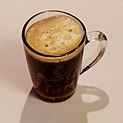 |
A traditional Russian honey-based drink with herbs and spices[47] |
| Varenets |  |
A fermented milk product that is popular in Russia.[48][49] Similar to ryazhenka, it is made by adding sour cream (smetana) to baked milk.[49] |
Alcoholic drinks
| Name | Image | Description |
|---|---|---|
| Medovukha |  |
A traditional Russian honey-based drink analogous to its counterparts of other Indo-European peoples[50] |
| Vodka |  |
It is composed primarily of water and ethanol, but sometimes with traces of impurities and flavorings. Traditionally it is made by distilling the liquid from cereal grains or potatoes that have been fermented, though some modern brands use fruits or sugar as the base. |
| Kvass |  |
A fermented cereal-based non-alcoholic or low alcoholic beverage with a slightly cloudy appearance, light-brown colour and sweet-sour taste. It stems from the northeastern part of Europe, where the grain production is thought to have been insufficient for beer to become a daily drink. In recent years it has regained its original popularity, often marketed as a national soft drink or "patriotic" alternative to cola. |
See also
References
Bibliography
Wikiwand - on
Seamless Wikipedia browsing. On steroids.
